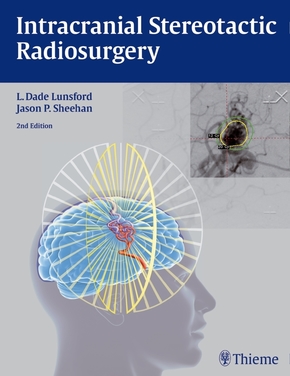
Intracranial Stereotactic Radiosurgery
| Verlag | Thieme |
| Auflage | 2015 |
| Seiten | 282 |
| Format | 22,4 x 28,8 x 2,0 cm |
| Hardback (Thread Stitching) | |
| Gewicht | 1176 g |
| Artikeltyp | Englisches Buch |
| ISBN-10 | 1626230323 |
| EAN | 9781626230323 |
| Bestell-Nr | 62623032UA |
This second edition is written by renowned experts in neurosurgery, neurology, physics, and radiation oncology, many of whom are pioneers of radiosurgery. Throughout more than 30 detailed chapters, the authors share their vast expertise on this highly precise, minimally invasive form of radiation therapy.
The first few chapters lay a foundation for understanding the differentiations in types of SRS technology: Leksell Gamma Knife, Novalis, Linac and Proton Beam Radiosurgery, and Cyberknife, followed by an explanation on the physics and radiobiology of SRS. The remaining chapters provide a detailed discussion of all pathologies and disorders currently treated.
Highlights:
- Radiosurgical procedures for a wide range of intracranial conditions/diseases including arteriovenous malformations, meningiomas, pituitary adenomas, trigeminal neuralgia, obsessive-compulsive disorder, epilepsy, ocular disorders, pediatric brain tumors, and gliomas.
- Important updat es on skull base tumors, functional disorders, and brain metastases.
- Evidence-based findings covering indications, patient selection, benefits, limitations, outcomes, potential complications, and alternative treatment modalities.
This updated reference tool is an invaluable, comprehensive guide to current concepts in SRS. It is a must-have resource for neurosurgeons, radiation oncologists, neuro-radiologists, and medical physicists, from residents to advanced clinicians.
Inhaltsverzeichnis:
Part I History
1 The Origins and Birth of the Leksell Gamma Knife
2 The History of Linac and Proton Beam Radiosurgery
3 The History of CyberKnife Radiosurgery
Part II Radiosurgical Fundamentals
4 The Radiobiology of Radiosurgery
5 The Physics of Radiosurgery
6 Radiosurgical Devices
7 Critical Structures and Tolerance of the Central Nervous System
8 The Neuropathology of Radiosurgery
Part III Vascular Indications
9 Stereotactic Radiosurgery for Arteriovenous Malformations
10 Stereotactic Radiosurgery for Cavernomas
11 Stereotactic Radiosurgery for Dural Arteriovenous Fistulas
Part IV Benign Tumor Indications
12 Stereotactic Radiosurgery for Meningiomas
13 Stereotactic Radiosurgery for Pituitary Adenomas
14 Stereotactic Radiosurgery for Chordomas
15 Stereotactic Radiosurgery for Chondrosarcomas
16 Stereotactic Radiosurgery for Glomus Tumors
17 Stereotactic Radiosurgery for Nonvestibular Schwannomas
18 Stereotactic Ra diosurgery for Hemangioblastomas
19 Stereotactic Radiosurgery for Vestibular Schwannomas
Part V Functional Indications
20 Stereotactic Radiosurgery for Trigeminal Neuralgia
21 Stereotactic Radiosurgery in Movement Disorders
22 Gamma Knife Radiosurgery for Obsessive Compulsive Disorder
23 Stereotactic Radiosurgery for Hypothalamic Hamartomas
24 Stereotactic Radiosurgery for Epilepsy
Part VI Ocular Disorder and Pediatric Tumor Indications
25 Stereotactic Radiosurgery for Ocular Disorders
26 Stereotactic Radiosurgery for Pediatric Brain Tumors
Part VII Malignant Tumor Indications
27 Radiosurgery for Glial Tumors
28 Stereotactic Radiosurgery for the Management of One to Four Brain Metastases
29 Stereotactic Radiosurgery for the Management of Five or More Brain Metastases
30 Repeat Radiosurgery for Brain Metastases
Part VIII Radiosurgical Horizon
31 Promising Advances in Radiosurgery: Where Are the Frontiers?
